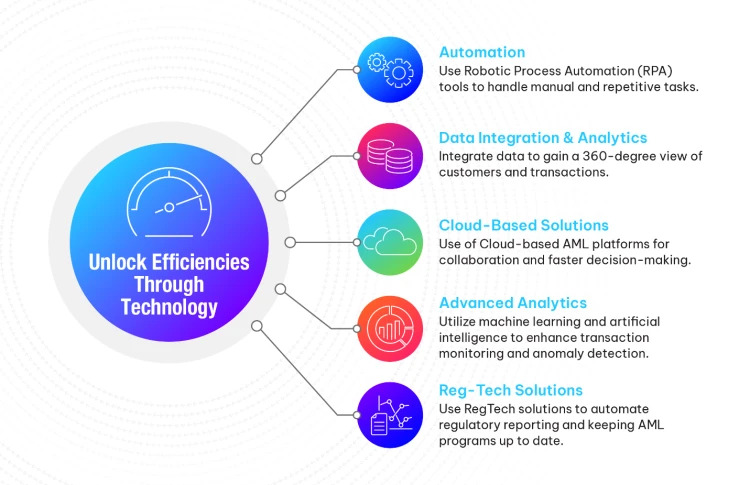The Hidden World of Money Laundering
Launderers use smart techniques to conceal the origin of illicit funds, making it hard to track their destination. As a result, dirty money flows into the financial system, harming the economy and society. This enables criminals to enjoy illegal profits without raising suspicion.
Meanwhile, law enforcement and authorities work tirelessly to detect and report suspicious transactions. However, fraud, drug trafficking, and terrorism continue due to weak compliance with anti-money laundering (AML) regulations. Therefore, financial institutions must comply with strict policies to stop financial crimes. Additionally, using software helps businesses track hidden ownership and prevent tax evasion. Otherwise, failing to follow regulations can lead to severe consequences.
To fight this, regulated entities must apply strong AML strategies and use monitoring tools to reduce impacts. Moreover, a comprehensive guide can help businesses understand common methods used by launderers. Ultimately, strengthening rules ensures a safer financial system and prevents illegal transactions.
Important Highlights
- Money laundering follows three phases: placement, layering, and integration. First, criminals move illegal funds through legitimate transactions. Then, they use techniques to conceal the origin of money. Finally, they reinvest it into legal businesses.
- To achieve this, criminals use shell companies and offshore accounts for financial cover. Additionally, cash smuggling, structuring, and wire transfers allow funds to cross borders. They also rely on cryptocurrencies, fake loans, and false invoices to avoid detection.
- As a result, the financial system suffers major impacts from fraud, corruption, and crime. This weakens the rule of law and erodes public trust in institutions. Furthermore, it threatens democracy by financing illegal activities worldwide.
- To combat this, AML compliance plays a critical role in protecting businesses. It helps prevent identity theft and ensures customer trust. Companies use software to detect fraud, enhance operational efficiency, and stay within regulations.
- Without strict compliance, the risk of financial collapse rises. Therefore, governments must act by monitoring ownership, enforcing stability, and ensuring transparency in all legitimate transactions.
The Dark Secret: How Money Laundering Works!
How Criminals Hide Dirty Money
Criminal organizations engage in illicit activities to make illegal profits. However, to use this wealth for legitimate purposes, they must first convert money into clean money through an illegal process. They begin by moving cash into the financial system using deposit methods at a bank or casino. To avoid detection and suspicion, they rely on cash smuggling, structuring, and mixing funds to disguise the source.
The Complex Web of Money Transfers
To break the link between the source and destination, criminals shift funds through multiple channels. They use wire transfers, shell companies, and offshore accounts to create confusion. Additionally, cryptocurrencies help them obscure the trail of transactions, making tracking harder. Once they feel secure, they withdraw the funds and invest in assets, fake businesses, or other holdings. Some even use false invoices, fake loans, or legitimate transactions to make everything appear legal.
The Consequences and Prevention Measures
Money laundering is not a victimless crime. It harms the economy, weakens the financial system, and endangers national security. Worse, it fosters corruption, erodes public trust, and damages confidence in the rule of law and democracy. To prevent and combat this crime, regulated entities enforce anti-money laundering (AML) policies. These measures include customer identification, verification (KYC), transaction monitoring, and reporting suspicious activities. Governments also implement record keeping, auditing, and AML case management while imposing sanctions and penalties. Through international cooperation and coordination, e-KYC strengthens AML compliance worldwide.
Sneaky Tactics: Money Laundering Techniques!
Clever Tricks Criminals Use to Hide Money
Criminals use many techniques to move illicit funds while avoiding scrutiny. They rely on anonymous services, peer-to-peer networks, and encrypted transactions to hide their tracks. Some create shell companies with nominee directors in offshore jurisdictions to disguise the origin of funds. Others deposit money into offshore accounts in foreign countries with low tax rates to bypass reporting requirements. Many use trade-based laundering, manipulating invoices or faking transactions to make money appear legal.
How Criminals Secretly Move Money
- Smurfing breaks large sums into small deposits across multiple accounts to avoid detection.
- Wire transfers send funds through encrypted channels, making tracking difficult.
- Laundering through gambling activities makes illegal cash look like winnings.
- Back-to-back loans involve fake lending between bank accounts to show false legitimacy.
- Charitable donations are used to move money under the disguise of philanthropy.
- Swaps help criminals exchange assets without paper trails.
- Invoice fraud inflates prices to justify illegal money transfers.
- Mail and vehicle smuggling move money physically across borders, avoiding digital records.
- Real estate deals blend illegal cash into the legitimate economy through property investments.
Evolving Strategies and AML Measures
Money laundering methods are evolving as criminals keep adapting to financial rules. They exploit weak AML regulations by creating ownership structures that obscure true control. Legitimate transactions become a cover for illegal funds, often masked by businesses with hidden motives. Authorities must combat this by improving KYC, strengthening reporting, and enforcing sanctions. Global cooperation through international coordination and AML compliance helps prevent this financial crime.
Conclusion
Money launderers use complex techniques to move illicit funds through the financial system without detection. Their activities follow the three phases of money laundering: placement, layering, and integration. These methods make it difficult to track the origin and destination of funds. Without strict AML compliance, criminals can exploit gaps in regulations and weaken the economy. To prevent fraud, financial institutions and regulated entities must enforce strict procedures and monitor suspicious transactions effectively.
However, fighting money laundering can be challenging and costly. Using reliable software helps automate compliance and improve operational efficiency. AML compliance tools assist in verifying customer identity, reducing the risk of identity theft, and ensuring compliance with AML regulations. Additionally, these solutions streamline reporting, detecting, and documenting illegal activities. By following best practices, businesses can save time, maintain legal standards, and avoid costly errors.
As AML trends continue to evolve, organizations must update their methods to stay ahead of criminals. Regulated entities should invest in advanced security solutions to protect society from financial crimes. Strengthening ownership controls and monitoring suspicious transactions builds customer trust and long-term business loyalty. With effective software, companies can enhance compliance, secure finances, and save money while reducing risks.

